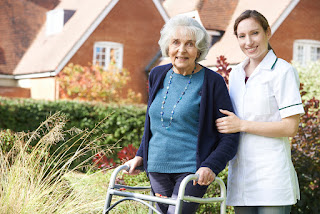Many people think of spring when they think of seasonal
allergies. However, allergy symptoms can occur in the fall as well. The
triggers for fall allergies may be different from those in the spring, but the
result is the same—sneezing, runny nose, and watery eyes. If your aging
relative is miserable in the fall, knowing more about fall allergies and how
you can help may make autumn more enjoyable.
Causes of Fall
Allergies
There are a few things that can stir up allergies in the
fall. Some of them are:
·
Ragweed:
This common plant is the number one cause of fall allergies. The plant usually
starts to release its pollen in August, which can continue into October.
According to WebMD, 75 percent of people who have spring allergies triggered by
pollen are also allergic to ragweed pollen. And, even if your aging relative
doesn’t live where the plant grows, wind can carry the pollen for hundreds of
miles.
·
Fruits
and Vegetables: Some people who are allergic to ragweed may also experience
symptoms from bananas, zucchini, and melons.
·
Mold:
Mold grows in damp areas, so the wet leaves that collect in the yard during the
fall are a perfect breeding ground.
·
Dust
Mites: When your aging relative turns on the furnace for the first time
during the cool fall months, it may stir up dust mites in heating ducts,
spreading them throughout the house.
Tips for Managing
Allergy Symptoms
Depending on the older adult’s symptoms, a doctor may
recommend medications. In addition, there are steps you can take at home to
prevent and relieve allergy symptoms, such as:
·
Watch the
Pollen Count: Check the daily pollen report available in many newspapers
and on the websites of local news stations. When the pollen counts are high,
keep the senior inside as much as possible.
·
Keep
Pollen Outside: Keep the doors and windows of the senior’s house closed.
Also, encourage people to remove their shoes and jackets before they come
inside so they don’t bring pollen in with them.
·
Vacuum
and Dust: Vacuum and dust the house regularly to get rid of any pollen that
does get inside.
·
Use a
Dehumidifier: A dehumidifier keeps humidity levels in the house lower,
which helps to control dust mites and mold spores.
Home care can assist with managing allergy symptoms. A home
care provider can remind the senior to take their allergy medications. They can
also help the older adult to check the daily pollen report. On days when counts
are high, home care providers can offer indoor activities to keep your loved
one from getting bored. Home care providers can also control pollen inside the
house by assisting with the vacuuming and dusting.
Sources
